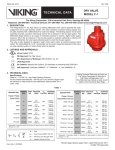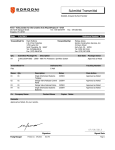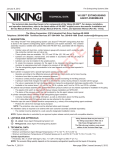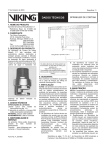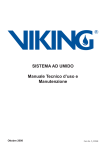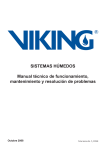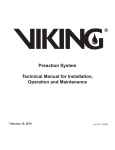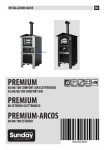Download Viking ATA-100 Technical data
Transcript
Firecycle 427a January 12, 2007 TECHNICAL DATA firecycle® III multi-cycle deluge system The Viking Corporation, 210 N Industrial Park Road, Hastings MI 49058 Telephone: 269-945-9501 Technical Services 877-384-5464 Fax: 269-945-4495 Email: [email protected] 1. DESCRIPTION (Refer to Figures 1 and 2) The Viking Firecycle® III Multi-Cycle Deluge System utilizes a Viking Model H or J Flow Control Valve (A.1) and a Firecycle® III Control Panel (E.3) with additional valves, devices, and trim to form a unique operating system. In addition to automatically detecting a fire and turning the system on, Firecycle® III has the added abilities to sense when the fire has been controlled, and automatically turn off the water flow once a preprogrammed “Soak Timer” has been satisfied. If the fire rekindles, Firecycle® III will initiate the sequence again. This unique cycling feature will repeat as long as power is available to the panel, helping to minimize water usage, water damage, and the danger of pollution to surrounding areas. Batteries are available to provide up to ninety (90) hours of emergency power. If the A.C. Power fails and the battery backup power expires while the system is operating, the deluge system will “fail-safe”, and continue flowing until A.C. Power is restored or the system is manually shut-off. The ��������������� Firecycle® III ������������ Multi-Cycle ������������������������������������������������������������������������������������������������������� Deluge System������������������������������������������������������������������������������������������ has several fail-safe features, some of which are not available on other deluge systems. Refer to Section B “System Operation” for details. Deluge systems are commonly used where it is desirable to simultaneously spray water from all open sprinklers and/or nozzles on the system when the system operates. Consult all Authorities Having Jurisdiction prior to installing a ���������������������������������� Firecycle® III Multi-Cycle Deluge System���������������������������������������������������������������������������������������������������������������������������������� . The ���������������������������������������������������������������������������������������������������������������������������� Firecycle® III Multi-Cycle Deluge System������������������������������������������������������������������������������������ requires use of a Viking Flow Control Valve and trim kit with two electric Release Solenoid Valves (E.1 and E.2) controlled by the Firecycle® III Control Panel (E.3), Firecycle® Detectors (E.4), and Detector Cable (E.5). For proper location, spacing, and positioning of detectors, refer to Technical Data describing Viking Firecycle® Detectors. NOTE: Firecycle® III is a complete system, and is listed as a unit. As such, it is normally not possible to modify the components of the system controls or their inter-relation without compromising the listing. For information on current approvals and permissible modifications to Firecycle® III, contact The Viking Corporation. 2. Listings and Approvals UL Listed - Category VLLA FM Approved - On-Off Multi-Cycle Sprinkler Systems 4. INSTALLATION Viking Technical Data may be found on The Viking Corporation’s Web site at http://www.vikinggroupinc.com. The Web site may include a more recent edition of this Technical Data Page. Refer to current Viking Technical Data describing individual components of the Viking Firecycle® III Multi-Cycle Deluge System. Technical Data describing the Viking Flow Control Valve and other system components are packed with product and in the Viking Engineering and Design Data book. Also refer to applicable installation standards, codes, and Authorities Having Jurisdiction. 1. The Flow Control Valve (A.1) and Trim must be installed only in areas where they will not be subjected to freezing temperatures or mechanical damage. 2. All indicating appliances and releasing devices must be compatible and approved for use with the Firecycle® III System. Refer to appropriate Fire Protection Equipment Approval Guides and current Viking Technical Data describing individual components of the Viking Firecycle® III System. 3. Use only Firecycle® Detectors (E.4) and Cable (E.5). Placing the System In Service (Refer to Figures 1 and 2) Note: Refer to Firecycle® III Owner’s Manual and instructions provided in Technical Data describing the Viking Flow Control Valve and other system components. 1. Verify that the Firecycle® III Control Panel (E.3), Detector Circuits, and Detectors have been properly installed and energized according to instructions provided in Viking Technical Data and the Firecycle® III Owner’s Manual. 2. Verify that the system has been properly drained. (When plunger is depressed on drip check, (B.7) no water should flow.) System Drain (D.3) should be open. Verify that Emergency Release (B.11) is closed. 3. Verify that the System Main Water Supply Control Valve (D.1) is closed and the Flow Control Valve (A.1) is trimmed according to current Viking Trim Charts and schematic drawings for the system used. 4. Verify that the system water supply piping is pressurized up to the closed System Main Water Supply Control Valve (D.1) and the priming line is pressurized up to the closed Priming Valve (B.1). 5. Open the Priming Valve (B.1). 6. Reset the Firecycle® III Control Panel (E.3) (Open panel and press “RESET”.) Release Solenoid Valve #1 (E.1) should close. Flow from Release Solenoid Valve #1 (E.1) to Drain Cup (B.14) should stop. 7. Open the Flow Test Valve (B.15). 8. Partially open the Main Water Supply Control Valve (D.1). 9. When full flow develops from the Flow Test Valve (B.15), close the Flow Test Valve. Verify that there is no flow from the open System Drain (D.3). 10. Close the System Drain (D.3). 11. Fully open and secure the Main Water Supply Control Valve (D.1) Form No. F_081596 Revised page replaces page 427 a-d dated March 16, 2004 (Revised Format, added “Multi-Cycle”) Firecycle 427b January 12, 2007 TECHNICAL DATA firecycle® III multi-cycle deluge system The Viking Corporation, 210 N Industrial Park Road, Hastings MI 49058 Telephone: 269-945-9501 Technical Services 877-384-5464 Fax: 269-945-4495 Email: [email protected] 12. Verify that the Alarm Shut-off Valve (B.9) is open and that all other valves are in their normal operating position. 5. OPERATION (Refer to Figures 1 and 2) In the SET condition: System water supply pressure enters the priming chamber of the Flow Control Valve (A.1) through the 1/4” (8 mm) priming line, which includes a normally open priming valve (B.1), strainer (B.2), restricted orifice (B.3) and check valve (B.4). In the SET condition, water supply pressure is trapped in the priming chamber by check valve (B.4), normally closed Release Solenoid Valve #1 (E.1), and normally closed Pressure Operated Relief Valve (P.O.R.V.) (B.10), and the normally closed Emergency Release (B.11). Water supply pressure in the priming holds the Flow Control Valve (A.1) clapper on the seat due to the differential design of the valve and spring pressure. The clapper separates the inlet chamber from the outlet chamber, keeping the outlet chamber and system piping dry. In fire conditions: In fire conditions, when the Firecycle® III Detection System (E.4 and E.5) operates, the Firecycle® III Control Panel (E.3) activates a piezo sounder and energizes normally closed Release Solenoid Valve #1 (E.1) open and normally open Release Solenoid Valve #2 (E.2) closed. Pressure is released from the priming chamber faster than it is supplied through the restricted orifice (B.3). The Flow Control Valve (A.1) clapper opens to allow water to flow into the system piping and to alarm devices, causing Alarm Pressure Switch (C.1) to activate. Water entering the system operates and hydraulically latches the P.O.R.V. (B.10) open. Water will flow from all sprinklers and/or spray nozzles attached to the system. Water discharges until all Firecycle® Detectors have reset, (cooled below their set point). After all detectors have reset, the Firecycle® III Control Panel (E.3) activates the “Soak Timer”, allowing the system to continue discharging water for a preset time period. When the “Soak Timer” has expired, the Firecycle® III Control Panel (E.3) de-energizes normally closed Release Solenoid Valve #1 (E.1), allowing it to close. (The normally open Release Solenoid Valve #2 (E.2) remains energized closed until the Firecycle® III Control Panel is manually reset, or both A.C. Power and battery backup have failed.) The Flow Control Valve (A.1) re-primes and closes, stopping the flow of water through the system piping. If a Firecycle® Detector goes into alarm, the Firecycle® III Control Panel (E.3) re-energizes normally closed Release Solenoid Valve #1 (E.1) open, and the entire cycle repeats. To return the system to “Normal” conditions, drain the system and relieve the pressure on the Pressure Operated Relief Valve (PORV) (B.10) by draining the outlet chamber of the Flow Control Valve (A.1). Replace any Firecycle® Detectors that have been damaged, and press the “System Reset” button on the Firecycle® III Control Panel (E.3) to clear all alarms. Trouble conditions: If the detection system is damaged or malfunctions, the Firecycle® III Control Panel will go into alarm and the Flow Control Valve will open. Water will flow from all sprinklers and/or spray nozzles attached to the system. The cycling function of the Firecycle® III System will not operate in this condition. All alarms will operate normally. Loss of Power Prior to Operation: If the AC power fails, the ��������������� Firecycle® III ������������ Multi-Cycle ��������������������������������������������������������������������������������� Deluge System�������������������������������������������������������������������� continues to operate on the standby batteries. If the AC power and the standby batteries fail prior to the operation of the system, all alarms would be lost, and the system must be manually activated. The cycling function of the system will not operate in this condition, and the system must be manually shut-off. Refer to Section D “Emergency Instructions” for further information. Loss of Power During Operation: If all power fails while the system is flowing water, the normally open Release Solenoid #2 will fail open. The P.O.R.V. (B.10) is already pressurized open, continually venting the priming chamber of the Flow Control Valve (A.1). The cycling function of the system will not operate in this condition, and the system must be manually shut-off. Refer to Section D “Emergency Instructions” for further information. Manual Operation: Any time the handle inside Emergency Release (B.11) is pulled, pressure is released from the priming chamber faster than it can be replaced through the priming line; the Flow Control Valve (A.1) will open. Water will flow from all sprinklers and/or spray nozzles attached to the system. The cycling function of the system will not operate in this condition, and the system must be manually shut-off. After operating the Emergency Release (B.11), do not close the Emergency Release until the system is ready to be reset. Emergency Instructions - ����������������������������� Taking System Out of Service� (Refer to Figures 1 and 2) WARNING: Placing a control valve or detection system out of service may eliminate the fire protection capabilities of the system. Prior to proceeding, notify all Authorities Having Jurisdiction. Consideration should be given to employment of a fire patrol in the affected areas. After a fire, verify that the fire is OUT and that placing the system out of service has been authorized by the appropriate Authority Having Jurisdiction. Sprinkler systems that have been subjected to a fire must be returned to service as soon as possible. The entire system must be in- Firecycle 427c January 12, 2007 TECHNICAL DATA firecycle® III multi-cycle deluge system The Viking Corporation, 210 N Industrial Park Road, Hastings MI 49058 Telephone: 269-945-9501 Technical Services 877-384-5464 Fax: 269-945-4495 Email: [email protected] spected for damage and repaired or replaced as necessary. 1. If All System Components Are Operational: a. Open System Drain (D.3). b. Silence alarms (optional): i. To silence electric alarms controlled by Firecycle® III Control Panel (E.3), open panel, and press “ALARM SILENCE” ii. To silence electric alarms not controlled by Firecycle® III Control Panel (E.1), close Alarm Shut-Off Valve (B.9). Note: Electric Alarms controlled by a pressure switch installed in the ½” (15 mm) NPT connection for a Non-interruptible Alarm Pressure Switch cannot be shut off until the Flow Control Valve is reset or taken out of service. c. To return to service immediately (when no maintenance or repairs are required) : i. Close the System Drain (D.3), if opened in step 1-A. ii. Open the Firecycle® III Control Panel (E.3) and press “RESET”. iii. Open the Alarm Shut-Off Valve (B.9) (if it was closed in step B-2 above). iv. Verify that all valves are secured in their normal operating position. (Refer to Figures 1 or 2 on page 427 d.) 2. If it is necessary to remove the Firecycle® III Multi-Cycle Deluge System from service: a. Close the Main Water Supply control Valve (D.1). b. Close the Priming Valve (B.1) (optional). If necessary, open the System Drain (D.3) to drain system and/or Test Valve (B.15) to drain the inlet chamber of the Flow Control Valve (A.1). c. Disconnect all power sources to the Firecycle® III Panel prior to performing any maintenance or repairs to the detection system (E.4, E.5), the panel (E.3), solenoid valves (E.1, E.2), or any electrical component of the system. 3. Perform all maintenance procedures recommended in Firecycle® III Owner’s Manual and Technical Data Pages for the individual components of the system that has operated. a. Replace any piping, detectors (E.4), or sections of detection cable (E.5) that have been damaged. Note: The complete system operation must be tested after servicing, changing programming, addition or deletion of system components, or after any modification, repair, or adjustment to system hardware or wiring. All components, circuits, system operation, or software functions known to be affected by a change must be 100% tested. b. Replace any sprinklers and/or spray nozzles that have been damaged or exposed to fire conditions. 4. 4. Restore AC power to Firecycle® III Control Panel (E.3). Ensure that standby batteries are charged or charging. Always connect and turn on AC power source prior to connecting the standby batteries. Connecting the standby batteries to the Firecycle® III Control Panel (E.3) before the AC power is connected and turned on may damage the panel. 5. 5. Return the system to service. Refer to Section E: “PLACING THE SYSTEM IN SERVICE”. 6. Inspections, Tests and Maintenance Inspections and Tests It is imperative that the system be inspected and tested on a regular basis. Refer to INSPECTIONS and TESTS recommended in current Viking Technical Data describing individual components of the Viking ��������������� Firecycle® III ������������ Multi-Cycle Deluge �������������� System�. Where difficulty in performance is experienced, the manufacturer or their authorized representative shall be contacted if any field adjustment is to be made. The frequency of the inspections may vary due to contaminated or corrosive water supplies or corrosive atmospheres. For minimum maintenance and inspection requirements, refer to NFPA 25. In addition, the Authority Having Jurisdiction may have additional maintenance, testing, and inspection requirements that must be followed. WARNING: Any system maintenance that involves placing a control valve or detection system out of service may eliminate the fire protection capabilities of that system. Prior to proceeding, notify all Authorities Having Jurisdiction. Consideration should be given to employment of a fire patrol in the affected areas. Maintenance NOTICE: The owner is responsible for maintaining the fire protection system and devices in proper operating condition. To perform maintenance on Detection cable or Detectors without taking the entire system out of service, disable input zone #1. Disabling Input zone #1 disables the detection cable and detectors, leaving the ability to operate the Deluge System manually by use of the Emergency Release or any manual pull stations (if provided) connected to input circuit 2. Note: When zone #1 is disabled, if it is necessary to activate the system using the Emergency Release or a manual pull station connected to input circuit #2, do not reset the Emergency Release or manual pull station used or the system may cycle off. When input zone #1 is disabled, the Firecycle® III Detector Cable remains charged with a maximum short circuit current of 40mA of 24 Firecycle 427d January 12, 2007 TECHNICAL DATA firecycle® III multi-cycle deluge system The Viking Corporation, 210 N Industrial Park Road, Hastings MI 49058 Telephone: 269-945-9501 Technical Services 877-384-5464 Fax: 269-945-4495 Email: [email protected] VDC. When disabled, an open circuit condition on input circuit #1 will cause the trouble relay to activate and the system trouble LED to activate, but will not activate any output circuit associated with input #1. To disable input circuits and associated output circuits for maintenance, refer to Firecycle® III Owner’s Manual and applicable Firecycle® III wiring diagram to determine which output circuits are activated by each input circuit. 1. Open the Firecycle® III Control Panel. (E.3) 2. Press and hold TONE SILENCE button 3. While holding the TONE SILENCE button, press the following buttons in sequence: ALARM SILENCE, ALARM ACTIVATE, and SYSTEM RESET. a. The zone #1 LED will flash indicating Zone #1 is selected. To disable zone #1, continue holding the TONE SILENCE button and press SYSTEM RESET once (again). The yellow LED will flash indicating zone #1 is disabled. b. To disable subsequent zones, continue holding the TONE SILENCE button and press the ALARM SILENCE button to select the next zone (the LED will flash on the zone selected) or ALARM ACTIVATE button to select the previous zone. Continue to holding ALARM SILENCE and press SYSTEM RESET to disable a selected zone. When disabled, the yellow LED will flash indicating the zone is disabled. 4. When desired zones are disabled, release the TONE SILENCE button. The Piezo sounder will sound. 5. To silence the Piezo, press TONE SILENCE. 6. To re-enable a disabled zone, repeat the procedure. Note: If any zone has been disabled, the Trouble Relay will activate and the System Trouble LED will flash. If a zone has been disabled, an alarm that occurs on that zone will flash the red zone LED, but will not sound the Piezo or activate any output circuit. If both power sources are removed from the system, all zones will be re-enabled upon restoration of power. Disable status is lost. Refer also to MAINTENANCE INSTRUCTIONS provided in current Viking Technical Data describing individual components of the Viking ����������������������������������������� Firecycle® III Multi-Cycle Deluge System�. 7. AVAILABILITY The Viking Firecycle® III Multi-Cycle Deluge System is available through a network of domestic and international distributors. See the Viking Corp. Web site for closest distributor or contact The Viking Corporation. 8. GUARANTEE For details of warranty, refer to Viking’s current list price schedule or contact Viking directly. Firecycle 427e January 12, 2007 firecycle® III multi-cycle deluge system TECHNICAL DATA The Viking Corporation, 210 N Industrial Park Road, Hastings MI 49058 Telephone: 269-945-9501 Technical Services 877-384-5464 Fax: 269-945-4495 Email: [email protected] Component A Description Part Numbers Corresponding Data Pages Various 500 - 508 System Valve A.1 Flow Control Valve Firecycle® III Trim (Trim and Flow Control Valve is included with the Package Part Numbers shown below) B C B.1 Priming Valve (Normally Open) B.2 Strainer B.3 1/8” Restricted Orifice Firecycle® III Valve and Trim Packages 1-1/2” B.4 Spring Loaded Check Valve B.5 Alarm Test Valve (Normally Closed) B.6 Drip Check Valve B.7 Drain Check Valve B.8 Alarm Shut-Off Valve (Normally Open) B.9 Pressure Operated Relief Valve (PORV) 2” B.10 Emergency Release B.11 Priming Pressure Water Gauge and Valve B.12 Water Supply Pressure Gauge and Valve B.13 Drain Cup B.14 Flow Test Valve (Normally Closed) C.1 Water Flow Alarm Pressure Switch 3” 4” 6” 8” Angle 10100 Straight Through 126911 442 a-b 442 e-f Angle 10101 445 a-b Straight Through 126942 442 e-f Angle 10102 448 a-b Straight Through 126183 445 e-f Angle 10103 448 a-b Straight Through 123483 448 e-f Angle 10104 448 a-b Straight Through 123513 448 e-f Straight Through 121004 448 e-f Water Flow Alarm Equipment 09470 705 a-b - - Riser D D.1 Water Supply Control Valve D.2 System Drain (Recomended) Sized according to NFPA 13 Release System E E.1 Release Solenoid Valve # 1 (Normally Closed) Various E.2 Release Solenoid Valve # 2 (Normally Open) 11595 E.3 Firecycle® III Control Panel Various 433 a-h E.4 Firecycle® Detector Various 417 a-d E.5 Firecycle® Detector Cable Various 419 d-f 274 a-b Footnotes: Add inlet and outlet designation to base part number for straight through style valves. (TT - Threaded, FF - Flange X Flange, FG - Flange X Groove, GG - Groove X Groove) 1 Available in TT only 2 Available in TT and GG 3 Available in FF, FG and GG 4 Available in FF and GG Table 1 - System Components Refer to Figures 1 and 2 for component Identification Note: When viewing this Data Page online, blue text represents hyper links and will open the desired data page when clicked. Firecycle 427f January 12, 2007 TECHNICAL DATA firecycle® III multi-cycle deluge system The Viking Corporation, 210 N Industrial Park Road, Hastings MI 49058 Telephone: 269-945-9501 Technical Services 877-384-5464 Fax: 269-945-4495 Email: [email protected] Figure 1 - Angle Style Valve Form No. F_081596 Figure 2 - Straight Through Valve Revised page replaces page 427 a-d dated March 16, 2004 (Revised Format, added “Multi-Cycle”)







